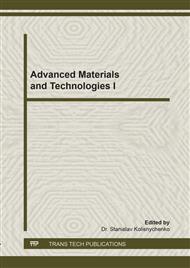[1]
Allwood, J.M., Ashby, M.F., Gutowski, T.G., Worrell, E. Material efficiency: providing material services with less material production. Philos Trans A Math Phys Eng Sci. 371 (2013) 1-15.
DOI: 10.1098/rsta.2012.0496
Google Scholar
[2]
Klein, M., Thorenz, B., Lehmann, C., Boehner, J., Steinhilper, R. Integrating New Technologies and Materials by Reengineering: Selected Case Study Results. Procedia CIRP. Vol. 50, No. 1, 2016, pp.147-152.
DOI: 10.1016/j.procir.2016.05.009
Google Scholar
[3]
Shirvanimoghaddam, K., Hamim, S.U., Akbari, M.K., Fakhrhoseini, S.M., Khayyam, H., Pakseresht, A.H., Ghasali, E., Zabet, M., Munir, K.S., Jia, S., Davim, J.P., Naebe, M. Carbon fiber reinforced metal matrix composites: Fabrication processes and properties. Compos. Part A: Applied Science and Manufacturing. Vol. 92, No. 1, 2017, pp.70-96.
DOI: 10.1016/j.compositesa.2016.10.032
Google Scholar
[4]
Callister, W.D. Ciência e engenharia de materiais: uma introdução, 8 ed., Rio de Janeiro, LTC, (2010).
Google Scholar
[5]
Anjos, I.P., Viorino, L.S., Ávila, A.F. Weight reduction of the pickup cargo bed by replacing metal panels with polymer composite materials. In: 24 ABCM International Congress of Mechanical Engineering, Curitiba, (2017).
DOI: 10.26678/abcm.cobem2017.cob17-2015
Google Scholar
[6]
Gutiérrez, J.C.H., Rubio, J.C.C., Faria, P.E. Usinabilidade de Materiais Compósitos Poliméricos para Aplicações Automotivas. Polymer. 24 (2014) 711-719.
DOI: 10.1590/0104-1428.1582
Google Scholar
[7]
Yetgin, S.H., Unal, H., Mimaroglu, A. Usability of injection moulded polypropylene and TALC-EPDM filled PP composite foam materials in automotive industry. Int. J. Vehicle Des. 71 (2016) 364-376.
DOI: 10.1504/ijvd.2016.078794
Google Scholar
[8]
Magalhães, M.D.M. Cálculo e projeto de banco para automóvel desportivo em materiais compósitos, Dissertação de M.Sc., U.Porto, Porto, Portugal, (2015).
Google Scholar
[9]
Bello, S.A., Agunsoye, J.O., Hassan, S.B., Kana, M.G.Z., Raheem, I.A. Epoxy Resin Based Composites, Mechanical and Tribological Properties: A Review. Trib in Ind. 37 (2015) 500-524.
Google Scholar
[10]
Dér, A., Kaluza, A., Kurle, D., Herrmann, C., Kara, S., Varley, R. Life Cycle Engineering of Carbon Fibres for Lightweight Structures. Procedia CIRP. Vol. 69, No. 1, 2018, pp.43-48.
DOI: 10.1016/j.procir.2017.11.007
Google Scholar
[11]
Alsaadi, M., Bulut, M., Erkliğ, A., Jabbar, A. Nano-silica inclusion effects on mechanical and dynamic behavior of fiber reinforced carbon/Kevlar with epoxy resin hybrid composites. Compos Part B: Eng. 152 (2018) 169-179.
DOI: 10.1016/j.compositesb.2018.07.015
Google Scholar
[12]
Ashby, M.F. Seleção de Materiais no Projeto Mecânico, 4 ed., Rio de Janeiro, Elsevier, (2012).
Google Scholar
[13]
Burge, S., The System Engineering Tool Box: Pugh Matrix, article by Burge Hughes Walsh, Reino Unido, 2009, pp.1-15.
Google Scholar
[14]
Rocha, V.R., Ávila, S.M. Análise estática e dinâmica de uma suspensão de fórmula SAE via elementos finitos. In: XXXVII Ibero-Latin American Congress on Computational Methods in Engineering - CILAMCE, Brasília, (2016).
DOI: 10.20906/cps/cilamce2015-0471
Google Scholar
[15]
Kulekci, M.K. Magnesium and its alloys applications in automotive industry. J. Adv. Manuf. Technol. Vol. 39, No. 9-10, 2008, pp.851-865.
DOI: 10.1007/s00170-007-1279-2
Google Scholar
[16]
Joost, W.J., Krajewski, P.E. Towards magnesium alloys for high-volume automotive applications. Scripta Materialia. 128 (2017), 107-112.
DOI: 10.1016/j.scriptamat.2016.07.035
Google Scholar
[17]
Sert, A., Gürgen, S., Çelik, O.N., Kuşhan, M.C. Effect of heat treatment on the bending behavior of aluminum alloy tubes. J. Mech. Sci. Technol. Vol. 31, No. 11, 2017, pp.5273-5278.
DOI: 10.1007/s12206-017-1020-5
Google Scholar
[18]
Gürgen, S. A parametric investigation of roller hemming operation on a curved edge part. Archives of Civil and Mechanical Engineering. Vol. 19, No. 1, 2019, pp.11-19.
DOI: 10.1016/j.acme.2018.07.009
Google Scholar
[19]
Gur, Y., Wagner, D. Damping properties and NVH Modal Analysis Results of Carbon Fiber Composite Vehicle Components. SAE Int. J. Mater. Manf. 10 (2017) 198-205.
DOI: 10.4271/2017-01-0500
Google Scholar
[20]
Araujo, M.R., Naveiro, R.M. Desenvolvimento de novos materiais e novos produtos na indústria automobilística. In: XIX ENEGEP / V International Congress of Industrial Engineering, Rio de Janeiro, (1999).
DOI: 10.1590/s0103-65131998000100003
Google Scholar


